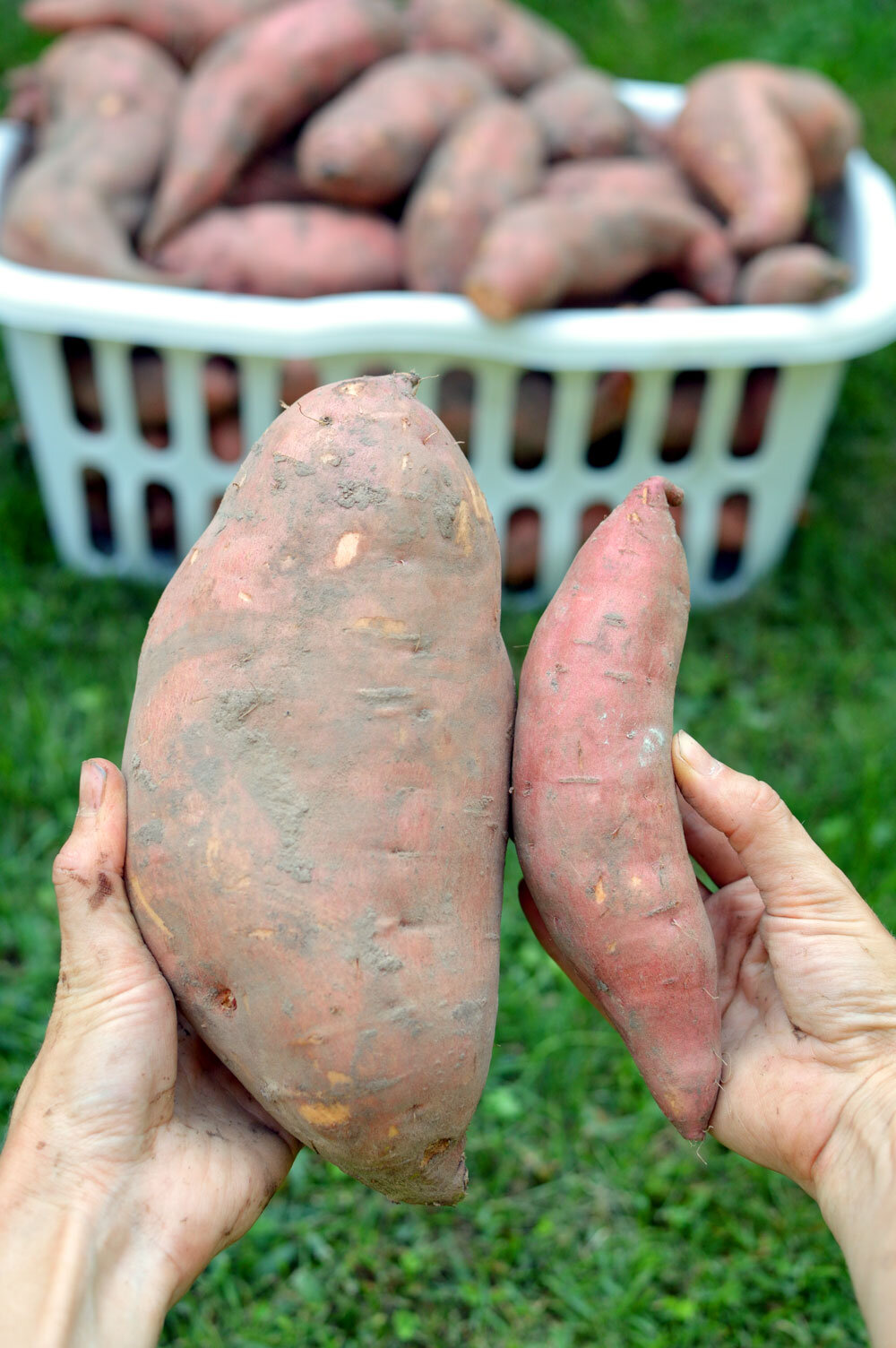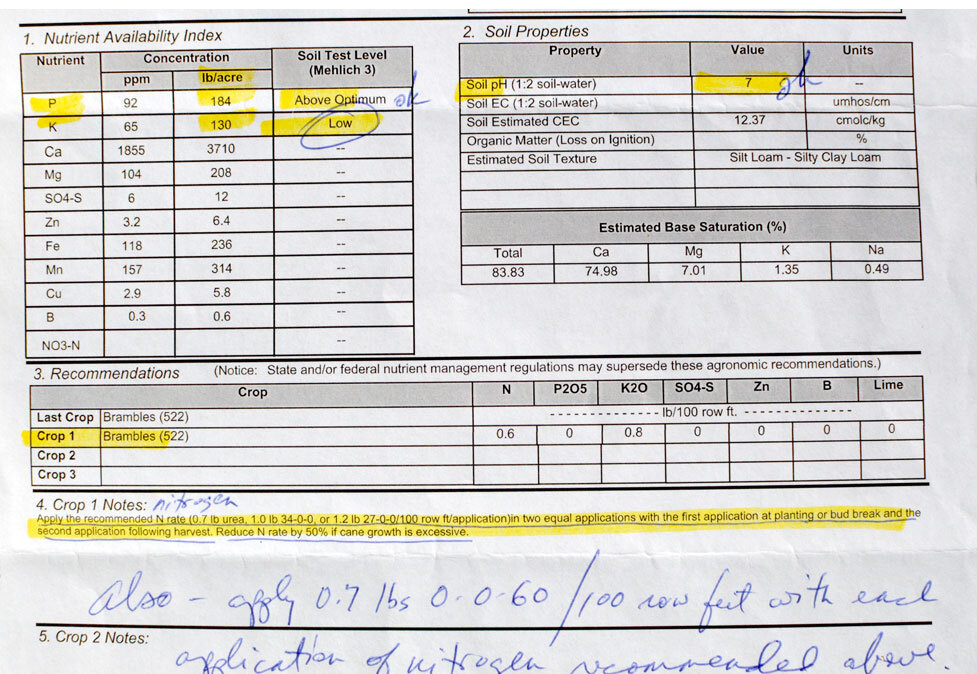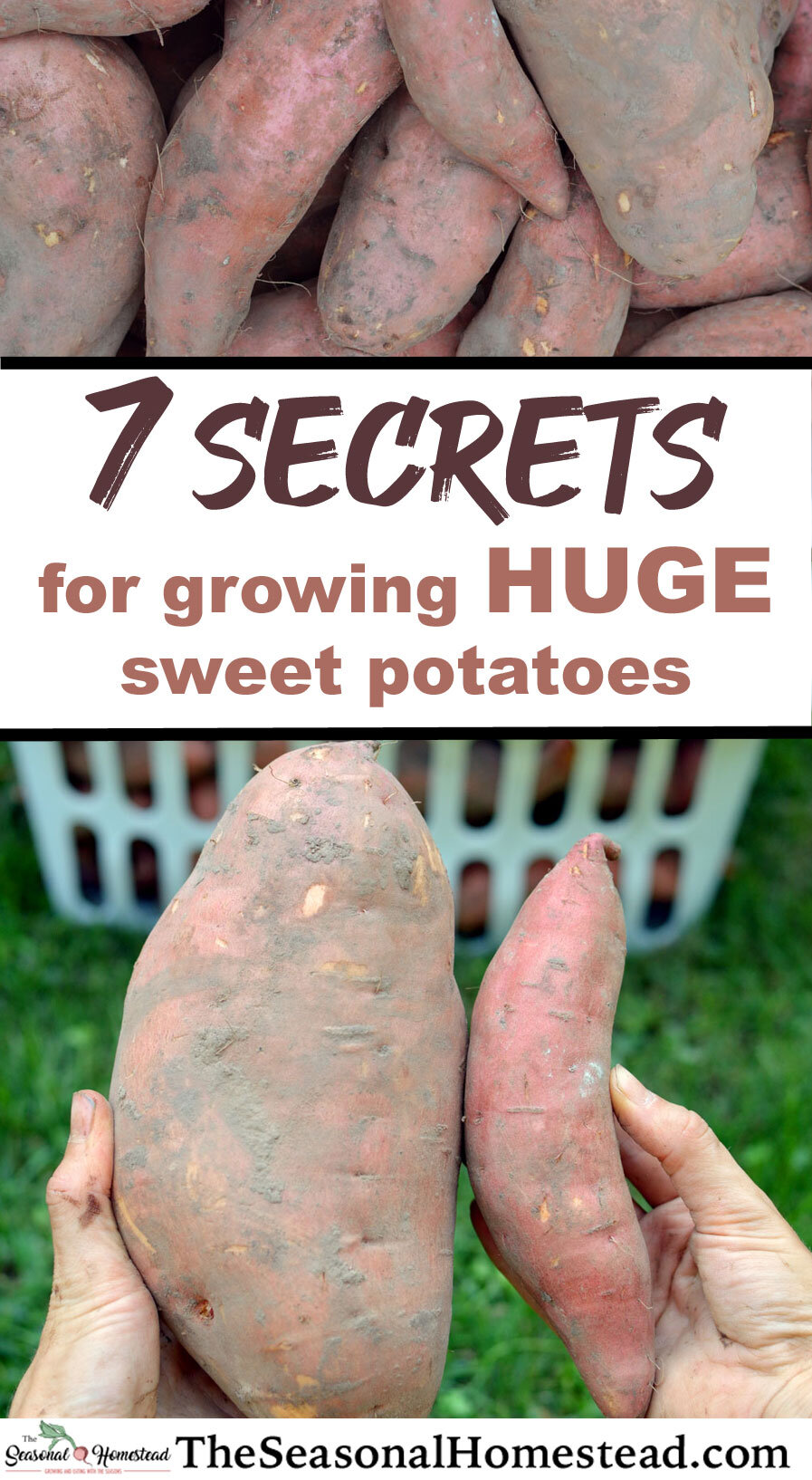7 Secrets For Growing HUGE Sweet Potatoes
My first year of growing sweet potatoes was also my worst sweet potato harvest year ever. They were so small and I harvested very few. Thank goodness for learning from mistakes. I’ve been consistently growing massive sweet potatoes every year since. I made 7 changes to the way I grew them the first year and it really paid off. Here are my 7 Secrets for growing huge sweet potatoes.

#1 Don’t add nitrogen or too much compost to the soil
This is the number one mistake people make when growing sweet potatoes. Sweet potatoes do not need rich, fertile soil! If the soil is too rich in nitrogen the result will be lots of green leaves and very small potatoes. I love it when the best answer to problems is to just do nothing!
This post contains affiliate links. Here is the full disclosure.
#2 Make sure your soil has enough phosphorus, potassium, and minerals
Sweet potatoes thrive on phosphorus and potassium. My soil has always been off the charts with phosphorus so I never even have to think about adding it.
Potassium on the other hand I have had to add. Initially, I almost wrote on here, “add potassium” but perhaps not everyone has soil with low potassium. Lucky you!
If you don’t know whether you have enough of the amendment or not, send your soil off to get tested. The results will be so beneficial. Here are more details on how to test your soil with what I consider to be the best professional soil test kit.
 Soil Test I did with my raspberries. This is what our results look like in arkansas. I usually do the adjustments myself to convert recommendations to organic amendments.
Soil Test I did with my raspberries. This is what our results look like in arkansas. I usually do the adjustments myself to convert recommendations to organic amendments.
Now onto the adding part, for those of us who need to do that. Potassium is tricky to add if you’re growing organically. The best organic form of potassium I’ve found is green sand. While I question the sustainability of this amendment, I still use it because it’s the best thing I’ve found. Not only does it add potassium, it also adds a plethora of minerals.
Another option is to add wood ash to add potassium. Keep in mind that wood ash will raise the soil PH and also add soluble salts. Too much wood ash can be detrimental to the soil but in moderation it is fine. It is difficult to find exact application rates but there is some useful information about wood ash application rates.
#3 Soil should be a sandy-loam
Sweet potatoes like sandy loam. The definition of sandy loam is less than 7 percent clay, less than 50 percent silt, and between 43 and 50 percent sand.
A soil test will tell you what you currently have in your garden. You can also do any easy at home test! This would be fun for kids to try. Here is a great article on how to do an at home soil test.
My most recent soil test said I have Silty Clay Loam. I have plenty of organic matter that has built up in the soil over the years so I always add a few buckets of sand before planting the sweet potatoes because I am low in sand.
You may need to think twice about adding buckets of sand to a clay soil without the additional organic matter. The fear is that it will form into something similar to concrete, so be mindful of that. You can add sand to loamy soil if needed.

#4 Grow in Full sun
Remember me talking about my worst sweet potato year ever? Well, I also happened to be growing in a location that was only getting 6 hours of sunlight. That is on the low end of sun needed for most vegetables. Full sun means the plants need at least 8 hours of uninterrupted sunlight.
#5 Give them lots of water
You probably already know that vegetables need to be watered. And yet for sweet potatoes, deep watering is even more critical to their growth. Watering plants deeply every few days is better than watering a little bit every day. Pay attention to the weather and how often and heavily it rains. Supplement with additional water if the soil is drying out.
#6 Wait until the right time to harvest
I’ve heard many people say the ideal time to harvest sweet potatoes is just before the first frost. While this may be true for certain long maturing varieties of sweet potatoes and northern climates, with the variety I grow (beauregard), I usually harvest earlier. Here is tons of detailed, tried and true information on when to harvest sweet potatoes.
The other benefit of digging at the right time is that you have a few weeks to cure the potatoes with heat naturally. Sweet potatoes cure best in 80-85 degree temperatures with 80-90% humidity. If you’re already in the southern US, you’ll have ideal circumstances outdoors for curing. You’ll want to cure out of direct sun, under a covered patio, in a garage, barn, or shed.
If you live in a colder climate, you’ll be harvesting just before the first frost so you’ll need to duplicate the curing process a different way. Wrapping sweet potatoes in damp paper towels and setting out next to a warm wood stove will cure sweet potatoes properly indoors.

#7 Grow the right variety for your area
If you want large sweet potatoes, I would grow a variety that is known for its large size. As I already mentioned, I personally grow Beauregard. It’s a very popular variety that is easy to find, easy to grow, and has a large yield.
I’ve grown a few other varieties but none even came close to the size and yield of Beauregard. It’s not the only good variety out there, you can be creative and test other varieties in your own climate!
Seed descriptions will often make note of positive characteristics of any given variety if you are looking for different types.
If you live in a colder northern climate, pick a variety that matures quickly. Your cooperative extension for your state (if in US) will usually have good recommendations of what will grow well in your area.
To Recap:
Don’t add nitrogen or too much compost to the soil
Make sure your soil has enough phosphorus, potassium, and minerals
Soil should be a sandy-loam
Grow in full Sun
Give them lots of water
Wait until the right time to harvest
Grow the right variety for your area



